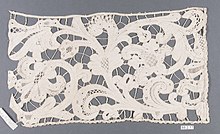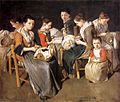

Milanese bobbin lace is a textile used as a fashion accessory or a decorative trim, first becoming popular in the 17th and 18th centuries in Milan. Lacemaking was an important economic activity in Northern Italy, besides touching on social status matters as well as being a culturally significant art form. The earliest versions of the lace consisted of the tape (or braid) mostly filling the space. Typical characteristics of Milanese bobbin lace are scrolls made with curving clothwork tapes and floral motifs, and sometimes also consisting of human or animal figures. Sometimes needle lace techniques were combined with the bobbin lace pieces to create the final product.
The lace eventually was made in parts, and joined by bridges or filled in with mesh grounds between existing pattern motifs. Novel ornamental features such as small beads affixed for eyes are sometimes found, as well as folded tallies and wheatears that add dimension to figures or edges.
Use of the lace in Ecclesiastical settings such as altar cloths and vestments likely represented Church support of the regional lacemaking. Examples of chalice cloths display the lace as edging, for example. Additionally, larger flounces might relay Biblical tales such as the example of the Old Testament story of Joseph, with many human, animal, and even astronomical motifs. Fashion uses, such as collars and cuffs, have also been documented.
Commissions of lace by wealthy patrons for weddings or other notable occasions might include family coat-of-arms displayed in the lace.
After the early Milanese laces from Milan developed, using less refined linen threads, a tape or braid style lace also arose in Flanders in the 17th century. The Flemish lace had much similarity to the Italian version, but typically worked with finer flax thread. It is sometimes difficult to distinguish the styles, and today they are considered to be under the Milanese name in a generic way.
Lacemaking has continued through the centuries, adapting to later fashion styles and other influences. The original styles are said to have influenced the tape laces of eastern European styles such as Russian, Hungarian, and Slovak laces. Milanese lace continues to be made today with nods to historical tapes and other motifs but with new artistic formats such as the work of Louise Colgan and colorways reminiscent of watercolors by Sandi Woods. Although there may be controversy over the use of color, patterns relying on thread color are available. Instructional pattern books make the recreation of the traditional laces possible for lacemakers today, as well as expanding the range into contemporary styles. Other textile artists also expand the fiber choices and colors with larger patterns and designs.
Gallery
-
 18th century Milanese lace depicting biblical story of Joseph
18th century Milanese lace depicting biblical story of Joseph
-
 Bobbin Lace (Bride Ground) Border 504.1915.c (detail)
Bobbin Lace (Bride Ground) Border 504.1915.c (detail)
-
 Bobbin Lace (Bride Ground) Border 504.1915.c
Bobbin Lace (Bride Ground) Border 504.1915.c
-
 Fragment of Milanese bobbin lace, dating from the 18th century
Fragment of Milanese bobbin lace, dating from the 18th century
-
 Chalice Veil - Cleveland Museum of Art
Chalice Veil - Cleveland Museum of Art
-
 Wide edging lace, Italy, Milan, 17th century, HAA
Wide edging lace, Italy, Milan, 17th century, HAA
-
 Insertion MET DP5481 49.32.19
Insertion MET DP5481 49.32.19
-
 Strip MET DP16313 09.68.197
Strip MET DP16313 09.68.197
-
 Manifattura canturina, tovaglie da the, 1925-50 ca. 02
Manifattura canturina, tovaglie da the, 1925-50 ca. 02
-
 Giacomo Ceruti - Women Working on Pillow Lace (The Sewing School)
Giacomo Ceruti - Women Working on Pillow Lace (The Sewing School)
References
- ^ Hohti, Paula (2022). ""Monstrous Ruffs" and Elegant Trimmings: Lace and Lacemaking in Early Modern Italy". In Cormack, Emma; Majer, Michele (eds.). Threads of Power : Lace from the Textilmuseum St. Gallen (1 ed.). New York: Bard Graduate Center. pp. 70–73. ISBN 9780300263497.
- Corbet, Barbara (2017). Mailänder Spitze gestern und heute = Milanese lace : yesterday and today. Inh. Dagmar Jenkel e.K. Barbara Fay Verlag und Versandbuchhandlung. Gammelby. p. 8. ISBN 978-3-925184-16-1. OCLC 989775056.
{{cite book}}: CS1 maint: location missing publisher (link) - Earnshaw, Pat (1982). A Dictionary of Lace. Princes Risborough, Aylesbury, Bucks, UK: Shire Publications. p. 111. ISBN 9780852636022.
- ^ Levey, Santina M. (1983). Lace : A History. . p. 34. ISBN 978-0901286154.
{{cite book}}: CS1 maint: location missing publisher (link) - Kurella, Elizabeth M. (1998). Guide to Lace and Linens. Dubuque, Iowa: Antique Trader Books. p. 173. ISBN 978-0930625894.
- Museum, Victoria and Albert. "Alb Apparel | V&A Explore The Collections". Victoria and Albert Museum: Explore the Collections.
- "Chalice Veil". Cleveland Museum of Art. 31 October 2018.
- "Bobbin Lace Flounce: Punto di Milano". Cleveland Museum of Art. 30 October 2018.
- Anonymous (2018-10-31). "Bobbin Lace Collar". Cleveland Museum of Art. Retrieved 2023-03-17.
- Anonymous (2018-10-31). "Bobbin Lace Cuff". Cleveland Museum of Art. Retrieved 2023-03-17.
- Bullock, Alice-May (1981). Lace and Lace Making. New York, N.Y.: Larousse. p. 135. ISBN 0883322617.
- Corbet, Barbara (2017). Mailänder Spitze gestern und heute = Milanese lace : yesterday and today. Inh. Dagmar Jenkel e.K. Barbara Fay Verlag und Versandbuchhandlung. Gammelby. pp. 8–10. ISBN 978-3-925184-16-1. OCLC 989775056.
{{cite book}}: CS1 maint: location missing publisher (link) - Earnshaw, Pat (1980). The Identification of Lace. Aylesbury, Eng.: Shire Publications. ISBN 9780852634844.
- Kurella, Elizabeth M. (2006). Guide to Lace and Linens. Dubuque, Iowa: Antique Trader Books. p. 172. ISBN 0930625897.
- Colgan, Louise. "Colgan Lace Studio". Colgan Lace Studio.
- Read, Patricia (1994). New braid and designs in Milanese lace. Internet Archive. London : B.T. Batsford. pp. 110–130. ISBN 978-0-7134-7192-2.
- Read, Patricia (2004). 50 Milanese lace patterns. London: Batsford. ISBN 978-0713489163.
- Corbet, Barbara (2017). Mailänder Spitze Gestern und Heute = Milanese lace : Yesterday and Today. Gammelby. pp. 177–234. ISBN 978-3925184161.
{{cite book}}: CS1 maint: location missing publisher (link) - Mirecki, Christine (2009). Mailänder Spitze modern interpretiert. C. Mirecki. OCLC 1258361284.
| Lace types | |||||||||
|---|---|---|---|---|---|---|---|---|---|
| Needle lace |
|  | |||||||
| Bobbin lace |
| ||||||||
| Tape lace | |||||||||
| Crocheted lace | |||||||||
| Machine-made lace | |||||||||
| Other handmade laces | |||||||||
| [REDACTED] Media related to Lace at Wikimedia Commons | |||||||||